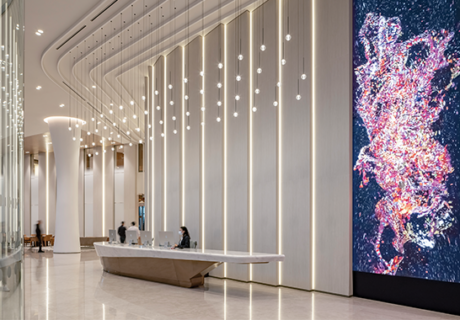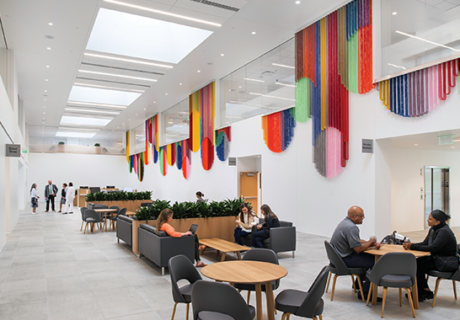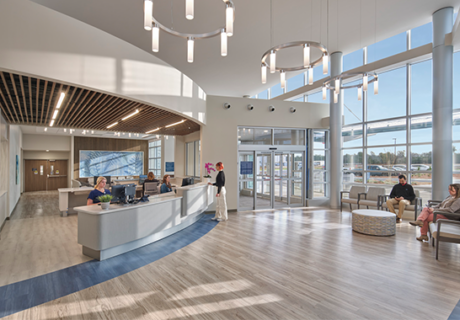Colors Of The World: Legacy Community Health Southwest Clinic
The southwest side of Houston is home to two adjoining and struggling neighborhoods: Gulfton and Sharpstown, where more than 30 percent of residents live below the poverty line and high rates of chronic disease persist. Legacy Community Health, a full-service Federally Qualified Health Center that operates 40 clinics in southeast Texas, sought to address those challenges. “We began seven years ago by purchasing a building with an existing practice to serve those neighborhoods,” says Joel Kalmin, director of facilities planning at Legacy Community Health. “Over time, we put that building through three extensive renovations to accommodate our growth there and provide expanded services.”
When a plot of vacant land adjacent to the clinic became available, Legacy saw its chance to expand in a major way and continue to meet growing demand for health services in the area. To accomplish that while keeping the existing 14,000-square-foot building open during construction, the new, 33,000-square-foot clinic was built on the vacant land; when it was finished, the old clinic was demolished to make room for a new dedicated 160-space parking lot. “We did an intensive survey of surrounding healthcare providers, as well as community needs, to make sure the new clinic would have an even greater impact on the community it serves than its predecessor,” says Kalmin.
Sitting on a 2-acre site and designed to serve more than 100,000 patients per year, the new clinic houses two new major services—adult medicine and an on-site pharmacy—as well as all the services offered at the previous location, including pediatrics, women’s health, behavioral health, an after-hours clinic, imaging, phlebotomy lab, immunization clinic, educational classrooms, and social services. The latter offerings include “a wide range of psychosocial services to patients and their families, including case management, patient advocacy, and psychological/social support,” Kalmin says.
Site specific
Hired by Legacy to deliver the new complex was Perkins&Will (Houston). Acting as the project’s master planner, architect, and interior designer, the design team utilized a rectangular building shape to fit the site’s narrow plot, with a full ground floor and a partial second one. That shape, in turn, drove the clinic’s entry experience, says Diana Davis, principal and managing director at Perkins&Will’s Houston studio. “Because much of the clinic’s clientele comes to it on foot or via public transportation, we used the end of the building with two floors to create an exterior alcove that offers some protection from the elements as they prepare to enter the building,” Davis says.
Inside, the center of the complex houses 64 exam rooms for primary care consultations and specialty services, including pediatrics and OB-GYN, with rooms grouped in three sets of 18 on the first floor and a single set of 18 more rooms on the second floor. Each of those pods has a spine of staff workstations running up its center. “The layout of the exam and team spaces was designed to increase the efficiency of patient care,” says Corrine Rojas, interior designer at Perkins&Will. “Each exam room is configured as an onstage/offstage experience with double-entry doors that allow for a patient’s care team to confer directly following an exam, while another team is simultaneously able to ready the room for the next patient.”
The 1,400-square-foot in-house pharmacy, which sits on the opposite end of the building from the main entrance, can be accessed via a public corridor that stretches the length of the facility, as well as from a dedicated exterior door. “The interior entrance for the in-house pharmacy minimizes the need for people to make additional stops elsewhere on their way home when they aren’t feeling well,” says Legacy’s Kalmin.
“Our integration of the pharmacy and the clinic improves medication adherence and, therefore, outcomes. We also included a separate, outdoor entry for those who aren’t coming directly from an appointment but need refills for their prescriptions.”
In addition to the exam rooms, the clinic’s smaller second floor houses classrooms for hosting community health classes, a community plaza for informal mingling, and an eligibility room where staff specialists meet with patients to arrange payment plans.
Perkins&Will also conducted extensive consultations with the clinic’s staff on their needs, which resulted in two specific staff amenity spaces—a break room with its own kitchen and a lactation room—also located on the second floor. Both areas are accessible via a private stairway that also provides staff with direct access to the other spaces on the floor. Beyond the second-floor offerings, designers also created eight break zones with couches and lockers along a first-floor private corridor with large windows. (That hallway is on the opposite side of the building from the main public corridor that links the lobby area and the pharmacy.)
Meaningful details
Beyond improving the patient and staff experience at the clinic, the project team sought to deliver a facility that connected with the community. That message begins at the entry experience with an exterior mural created by Houston-based artists Angel Quesada and Jesse Sifuentes. Using cathedral glass and acrylic enamel paint, the six 11-foot-tall panels are titled “Together With the Sun.” Inspired by the colors and motifs of textiles from Latin America, Asia, and Africa—the predominant home regions of the neighborhoods’ residents—the figures in the panels represent hopeful and iconic depictions of families and communal social structures, with the sun symbolizing life-giving warmth, Davis says.
Further reflecting the diversity of the area it serves—where residents originate from a total of 80 countries and speak 50 languages—the building’s exterior façade incorporates a bold color palette of bright turquoise, orange, and yellow hues to pay homage to the cultures and textiles of the previously mentioned regions as well as serve as a nod to Legacy’s logo.
A motif similar to the exterior plays out throughout the clinic’s interiors, including handcrafted panels by artisans from the African country of Senegal that are incorporated into the railing of the main stair and as privacy screens within the pharmacy. In addition, the interior’s public spaces feature mosaic tiled walls and backlit signage that serve as both cultural symbols and support for the clinic’s color-coded wayfinding system. “Because of all the languages spoken in the surrounding area, we thought it best to create color-coded zones throughout the space,” Rojas says. “Each entry and waiting zone is color-coordinated to its designated exam bay. So, for example, someone there for pediatrics follows the green-colored spaces throughout their visit.”
Put to the test
The clinic opened in December 2019. Just a few months later, as the first wave of COVID-19 was unfolding in the U.S., the new outdoor pharmacy parking zone was transformed into one of the first sites in the Houston area to provide free COVID-19 testing.
Such flexibility, Kalmin adds, illustrates how the new clinic has helped go “beyond our expectations in providing equitable healthcare for a high-risk community in a respectful and culturally sensitive way.”
Project details:
Project name: Legacy Community Health Southwest Clinic
Project completion date: December 2019
Owner: Legacy Community Health
Total building area: 32,852 sq. ft.
Total construction cost: $11.3 million
Cost/sq. ft.: $345
Architect: Perkins&Will
Interior designers: Perkins&Will, Legacy Community Health
General contractor: Harvey Builders
Engineers: Walter P Moore (structural and civil), E&C Engineers (MEP)
Builder: Harvey Builders
Public art consultant: WAG – Weingarten Art Group
Carpet/flooring: Patcraft, Tarkett
Ceiling/wall systems: Armstrong, Ceilings Plus
Doors/locks/hardware: DIRTT
Fabric/textiles: Standard Textile
Furniture—seating/casegoods: Staples, Allseating
Lighting: Delray, Luminis, 3Form, Corelite, Metalux, Atlantic Lighting, Neo-Ray, Nulite, Ametrix
Signage/wayfinding: Riot Creative Imaging, Neon Electric Co.
Surfaces—solid/other: Avonite Surfaces, 3Form
Wallcoverings: Wolf Gordon
Matthew Hall is a freelance writer/editor based in Cincinnati. He can be reached at matt.hall56@icloud.com.










